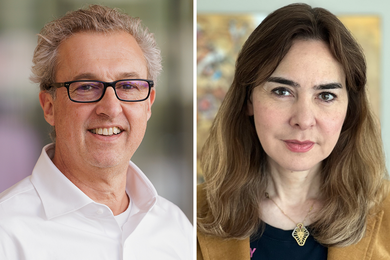It's a long, expensive, risky road to turn a scientific breakthrough into a treatment that can help patients. Fewer organizations are trying to tackle the challenges alone, says a new paper from MIT researchers published August 28 in the journal Science Translational Medicine.
An essential new way to move discoveries forward has emerged in the form of multi-stakeholder collaborations involving three or more different types of organizations, such as drug companies, government regulators and patient groups, write Magdalini Papadaki, a research scientist, and Gigi Hirsch, a health system innovator and executive director of the MIT Center for Biomedical Innovation.
The authors are calling for a new "science of collaboration" to learn what works and doesn't work; to improve how leaders can design, manage and evaluate collaborations; and to help educate and train future leaders with the necessary organizational and managerial skills.
"Getting new, better, affordable drugs to the right patients faster involves a series of historically independent decisions made by different players or stakeholders," Hirsch says. The system is uncoordinated, takes too long, and costs too much, she says. In some cases, the drug may never become available, such as new antibiotics for life-threatening resistant infections.
"One of the interesting paradoxes of biomedical innovation is increasingly going to be that even though we have the scientific knowledge required to provide potentially better treatments for patients — or even to prevent disease in those who are at high risk—we may be unable to help patients benefit from them anytime soon," she says.
To help change this scenario, in the last decade, thousands of researchers, pharmaceutical and biotechnology companies, government regulators, payers, clinicians and patients have come together in more than 100 multi-stakeholder collaborations to solve some specific shared problem standing in the way of finding a cure or a better diagnostic approach.
"Multi-stakeholder collaborations provide the opportunity to create an environment that allows for new kinds of interactions among the players," Hirsch says. The largest multi-stakeholder effort, the European Union’s Innovative Medicines Initiative began in 2008 and has established more than 40 consortia with financial and in-kind investments totaling 2 billion euros. Some projects focus on specific health issues, such as Alzheimer's disease, chronic pain, diabetes and obesity. Others tackle bigger issues, such as drug and vaccine safety and the use of stem cells for drug discovery. The success has led to a proposal to extend the effort for 10 years and 3.5 billion euros. Last year, the U.S. President’s Council of Advisors on Science and Technology (PCAST) recommended the U.S. form something similar.
"More than ever, multi-stakeholder collaborations are a necessity," says Michel Goldman, IMI executive director. Collaborations can offer a neutral platform to share information to improve the testing, approval, marketing and safety of new drugs. "It's about more than pure science," he says. It's about changes in health care economics, risk-benefit assessments of vaccines and new drugs, incentives and new business models to make some fields more attractive, Goldman says, and ensuring that patients have access to new medicines.
"The prevalence of multi-stakeholder initiatives reflects a continued optimism about the value of this collaboration approach for addressing biomedical innovation bottlenecks," the authors write in the paper. "Although the need for collaboration is no longer in question, it is worth noting the importance of this development. A willingness to share proprietary data among industry competitors represents a dramatic shift in the culture of the historically highly competitive pharmaceutical industry."
The article reviews the history of collaborations beginning with HIV/AIDS. By the early 2000s, multi-stakeholder collaborations proliferated to address the need for important tools, such as biomarkers, that require preclinical data sharing. Since then, their missions have expanded to encompass later stages in product development, including manufacturing, reimbursement, and post-market monitoring.
Some people involved in multi-stakeholder consortiums are concerned about redundancy, inefficiency and lack of productivity of some collaborative efforts, all contributing to a sense of "consortium fatigue," the researchers write.
In a newer trend, some funders and participants are seeking a smaller number of strategically coordinated initiatives that will reliably address critical gaps, Hirsch and Papadaki write. They cite the example of TransCelerate BioPharma, a group of 10 major pharmaceutical companies that came together to share and direct resources toward selected priorities in order to improve the efficiency of drug development, such as clinical trial site qualification standards.
"There's an increasing recognition that the challenges we have in biomedical research in general and drug discovery and development in particular are really too big for any individual scientist, company or even an institution as large as the National Institutes of Health," says Garry Neil, chairman of the TransCelerate board of directors.
Collaborations add more complexity to an already complex system of biomedical innovation, Neil says, but a major incentive for companies to participate is to avoid predictable failures. There are many examples of drug companies all working on a promising target and all failing for the same reasons, he says. "It's a lot of wasted resources that could have been better spent," he says. "It's all about improving the process."
The authors propose a rigorous evidence-based approach (the science of collaboration) to figure out what works and doesn't work in collaborations. They recommend early steps in this new field and structuring the research to help learn from the past but also to evolve effectively as new innovation challenges emerge.
"For me, the highest priority is to develop new and evolving systems to measure and reward people who are investing in collaborations and making them successful," Goldman says. Education and training is also a high priority. Goldman says people need to learn why collaborations are needed to achieve certain goals, how to manage collaborations, what information can be shared and not shared, and how to structure intellectual property agreements.
To launch their new discipline, the Robert Wood Johnson Foundation just awarded Hirsch and her colleagues a start-up grant. Their research will begin with case studies in collaborative biomedical innovation to identify the organization design components, as well as systematic learning from a broad range of collaborative innovation models in other industries.
In addition, Hirsch runs a real-world collaboration laboratory called New Drug Paradigms (NEWDIGS). The group is exploring more adaptive approaches to regulation. The effort aims to make innovative medicines available to the right patients faster. The approach is founded on a series of regulatory actions, rather than the current system of making a single "go/no go" decision at the end of a long and expensive development process. The group includes representatives from regulatory agencies around the world, European and U.S. payer and health technology assessment organizations, pharmaceutical companies, patients, providers and academic researchers.
An essential new way to move discoveries forward has emerged in the form of multi-stakeholder collaborations involving three or more different types of organizations, such as drug companies, government regulators and patient groups, write Magdalini Papadaki, a research scientist, and Gigi Hirsch, a health system innovator and executive director of the MIT Center for Biomedical Innovation.
The authors are calling for a new "science of collaboration" to learn what works and doesn't work; to improve how leaders can design, manage and evaluate collaborations; and to help educate and train future leaders with the necessary organizational and managerial skills.
"Getting new, better, affordable drugs to the right patients faster involves a series of historically independent decisions made by different players or stakeholders," Hirsch says. The system is uncoordinated, takes too long, and costs too much, she says. In some cases, the drug may never become available, such as new antibiotics for life-threatening resistant infections.
"One of the interesting paradoxes of biomedical innovation is increasingly going to be that even though we have the scientific knowledge required to provide potentially better treatments for patients — or even to prevent disease in those who are at high risk—we may be unable to help patients benefit from them anytime soon," she says.
To help change this scenario, in the last decade, thousands of researchers, pharmaceutical and biotechnology companies, government regulators, payers, clinicians and patients have come together in more than 100 multi-stakeholder collaborations to solve some specific shared problem standing in the way of finding a cure or a better diagnostic approach.
"Multi-stakeholder collaborations provide the opportunity to create an environment that allows for new kinds of interactions among the players," Hirsch says. The largest multi-stakeholder effort, the European Union’s Innovative Medicines Initiative began in 2008 and has established more than 40 consortia with financial and in-kind investments totaling 2 billion euros. Some projects focus on specific health issues, such as Alzheimer's disease, chronic pain, diabetes and obesity. Others tackle bigger issues, such as drug and vaccine safety and the use of stem cells for drug discovery. The success has led to a proposal to extend the effort for 10 years and 3.5 billion euros. Last year, the U.S. President’s Council of Advisors on Science and Technology (PCAST) recommended the U.S. form something similar.
"More than ever, multi-stakeholder collaborations are a necessity," says Michel Goldman, IMI executive director. Collaborations can offer a neutral platform to share information to improve the testing, approval, marketing and safety of new drugs. "It's about more than pure science," he says. It's about changes in health care economics, risk-benefit assessments of vaccines and new drugs, incentives and new business models to make some fields more attractive, Goldman says, and ensuring that patients have access to new medicines.
"The prevalence of multi-stakeholder initiatives reflects a continued optimism about the value of this collaboration approach for addressing biomedical innovation bottlenecks," the authors write in the paper. "Although the need for collaboration is no longer in question, it is worth noting the importance of this development. A willingness to share proprietary data among industry competitors represents a dramatic shift in the culture of the historically highly competitive pharmaceutical industry."
The article reviews the history of collaborations beginning with HIV/AIDS. By the early 2000s, multi-stakeholder collaborations proliferated to address the need for important tools, such as biomarkers, that require preclinical data sharing. Since then, their missions have expanded to encompass later stages in product development, including manufacturing, reimbursement, and post-market monitoring.
Some people involved in multi-stakeholder consortiums are concerned about redundancy, inefficiency and lack of productivity of some collaborative efforts, all contributing to a sense of "consortium fatigue," the researchers write.
In a newer trend, some funders and participants are seeking a smaller number of strategically coordinated initiatives that will reliably address critical gaps, Hirsch and Papadaki write. They cite the example of TransCelerate BioPharma, a group of 10 major pharmaceutical companies that came together to share and direct resources toward selected priorities in order to improve the efficiency of drug development, such as clinical trial site qualification standards.
"There's an increasing recognition that the challenges we have in biomedical research in general and drug discovery and development in particular are really too big for any individual scientist, company or even an institution as large as the National Institutes of Health," says Garry Neil, chairman of the TransCelerate board of directors.
Collaborations add more complexity to an already complex system of biomedical innovation, Neil says, but a major incentive for companies to participate is to avoid predictable failures. There are many examples of drug companies all working on a promising target and all failing for the same reasons, he says. "It's a lot of wasted resources that could have been better spent," he says. "It's all about improving the process."
The authors propose a rigorous evidence-based approach (the science of collaboration) to figure out what works and doesn't work in collaborations. They recommend early steps in this new field and structuring the research to help learn from the past but also to evolve effectively as new innovation challenges emerge.
"For me, the highest priority is to develop new and evolving systems to measure and reward people who are investing in collaborations and making them successful," Goldman says. Education and training is also a high priority. Goldman says people need to learn why collaborations are needed to achieve certain goals, how to manage collaborations, what information can be shared and not shared, and how to structure intellectual property agreements.
To launch their new discipline, the Robert Wood Johnson Foundation just awarded Hirsch and her colleagues a start-up grant. Their research will begin with case studies in collaborative biomedical innovation to identify the organization design components, as well as systematic learning from a broad range of collaborative innovation models in other industries.
In addition, Hirsch runs a real-world collaboration laboratory called New Drug Paradigms (NEWDIGS). The group is exploring more adaptive approaches to regulation. The effort aims to make innovative medicines available to the right patients faster. The approach is founded on a series of regulatory actions, rather than the current system of making a single "go/no go" decision at the end of a long and expensive development process. The group includes representatives from regulatory agencies around the world, European and U.S. payer and health technology assessment organizations, pharmaceutical companies, patients, providers and academic researchers.





